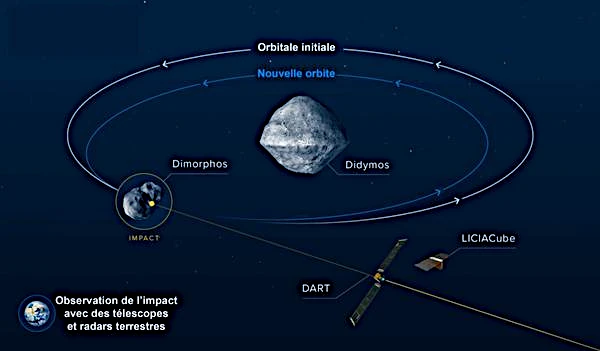
The binary system Didymos–Dimorphos is a pair of near-Earth asteroids of the S-type class. Discovered in 1996, Didymos (Greek for "twin") measures about 780 meters in diameter and rotates on its axis every 2.26 hours. Its companion, Dimorphos (Greek for "having two forms"), with a diameter of about 160 meters, orbits Didymos at an average distance of 1.18 km with an orbital period of 11 hours 55 minutes.
N.B.:
S-type near-Earth asteroids are rich in silicates and metals, primarily composed of olivine and pyroxene. Their high albedo (\(0.20 < p_V < 0.35\)) indicates relatively young surfaces. These objects, like Didymos, are common in the inner Solar System and belong to the NEO family.
These two asteroids form an inseparable duo, held together by their weak gravity. They are not solid rock blocks but rather rubble piles, making them very fragile and irregularly shaped. In other words, they are two clusters of rocks held together by minimal gravity.
The scientific interest in the Didymos–Dimorphos system lies in its orbital stability and the marked mass contrast between the two bodies (mass ratio of about 1:35). Didymos, the "twin," dominates the system with its gravity, while Dimorphos, the smaller body, acts as a natural satellite whose surface experiences constant alternation of light and shadow cast by its primary.
N.B.:
The name "Dimorphos" literally means "having two forms" in ancient Greek. It refers to the dual nature of the object: a natural satellite and an experimental target, whose shape and orbit were altered by the DART impact.
The geometry of this system allows precise measurement of the change in orbital period through occultations and lighting effects observed from Earth. This feature made the DART mission by NASA possible in 2022, designed to test orbital deflection via kinetic impact. The study of Didymos and its "shadow" Dimorphos provides a natural model for understanding the internal cohesion of small bodies and the complex dynamics of binary systems in the Solar System.
The DART mission (kinetic impact) struck Dimorphos on September 26, 2022, to demonstrate the ability to alter the trajectory of a near-Earth object through a controlled kinetic impact. The choice of the Didymos–Dimorphos binary system allowed for precise measurement: the satellite's orbital period before and after impact is accessible via photometry from Earth through mutual occultations. Consolidated analyses showed a shortening of the period by about 33 minutes (−33.0 ± 1.0 min).
For a close binary system, the orbital period \(T\) is related to the average distance \(a\) and the total mass \(M\) by the reduced form of Kepler's third law adapted for small masses: \(\; T = 2\pi \sqrt{\dfrac{a^{3}}{G M}}\;\).
A fundamental law of astronomy: There is a simple gravitational rule, stated by Kepler, which says: the closer an object is to what it orbits, the faster it moves. This is true for Earth around the Sun, the Moon around Earth, and Dimorphos around Didymos.
The DART mission did not "push" Dimorphos sideways, as is often believed. It primarily slowed it down in its orbit.
By slowing it down, DART caused Dimorphos to lose some of the energy that kept it in its orbit. As a result, it could not resist Didymos' attraction as much and moved closer. According to Kepler's law, as it gets closer, its orbital speed increases. The combination of "shorter distance" + "higher speed" results in a shorter total time to complete an orbit (the orbital period), which decreases.
This is exactly what was measured: Dimorphos' orbit became smaller and faster, shortening its "month" by 33 minutes. This dramatic change is direct proof that the impact successfully altered the asteroid's trajectory.
Close-up data and imagery indicate that Dimorphos is likely a rubble pile. A loosely cohesive structure favors the generation of voluminous ejecta and post-impact deformations. Studies have shown a shape change from oblate (flattened at the poles) → prolate (elongated along an axis).
The European Space Agency (Hera mission) aims to reach the Didymos system to measure the morphology of the crater, the mass, and the internal properties of Dimorphos in situ, and to validate momentum transfer models.
Hera will allow for precise estimation of \(\beta\), mapping the size distribution of blocks, and assessing macroscopic porosity. These measurements are essential for deducing the scalability of the kinetic impact method to potentially hazardous bodies for Earth.
Below is a synthetic table of the main experimental milestones, with observable references.
| Year | Event | Mission or Observatory | Comment |
|---|---|---|---|
| 1996 | Discovery of the asteroid Didymos | Kitt Peak Observatory | Identified as an S-type near-Earth asteroid |
| 2003 | Discovery of the satellite Dimorphos | Arecibo Observatory | Radar observation revealing the Didymos–Dimorphos binary system |
| 2022 | Impact of the DART mission on Dimorphos | DART – NASA | First demonstration of orbital deflection by kinetic impact |
| 2024–2026 | Preparation and launch of the Hera mission | ESA | Observation of the formed crater and precise measurement of the deflection |
Source: NASA – DART Mission and ESA – Hera Mission.